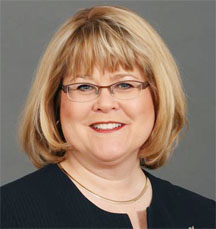Canada is working with Guyana on a mineral mapping project and there are 28 Canadian exploration companies here operating in gold, bauxite, oil and gas, manganese, uranium and other precious metals, according to Canadian Minister of State of Foreign Affairs, Diane Ablonczy.
The minister visited Guyana last week and in a reception at the Canadian High Commissioner’s residence, said that Canadian companies have invested hundreds of millions of dollars in the country’s extractive sector. It is critical to both Guyanese development prospects and Canadian business to sustain this momentum, she said, according to a transcript of her remarks.
Ablonczy said that the government of Canada is working with the Ministry of Natural Resources and the Environment to build capacities that are needed in education to support the developments in the extractive sector. Projects include support for the Association of Community Colleges’ extractive sector programme and support for the mining school. “We are also working with the ministry on a mineral mapping project,” she said.

Meanwhile, the minister noted that on a bilateral level, Canadian merchandise trade with Guyana was valued at over $400 million in 2011, and Guyana now ranks second in Caricom as a trading partner.
She said that the relationship between the two nations is growing and nowhere is this more evident than in terms of trade and rapidly growing Canadian investment in Guyana, particularly in the natural resource sector. “We in Canada understand the complexities and challenges that Guyana is facing, especially in a world full of global changes. Development is another area where Canadian involvement continues to be important,” Ablonczy added.
She said that the Canadian International Development Agency’s 12-year, CDN$600 million development assistance programme for the Caribbean region, aligns with the region’s priorities for economic growth. It focuses on helping to build a more prosperous and integrated Caribbean Community that is able to better provide opportunities and more security to its citizens, she said.
The minister said that through the Canada Fund for Local Initiatives (CFLI), several areas of Guyana have benefited from these projects. The CFLI, a small fund, has carried out projects like the Buxton Youth Developers Project, which she visited and which started with 30 students and now serves more than 300.
Through CFLI, Guyana’s indigenous communities have also been beneficiaries, such as, the guest house and boardwalk that were constructed at Lake Capoey Village, which are aimed at providing employment through the promotion of eco-tourism, the minister noted.
She said that Canada has also worked closely with other Guyanese partners in the areas of the environment, democracy and security while Canada’s relationship with Guyana is also integral to our relationship with CARICOM.
“As many of you know, Canada and CARICOM held a fourth round of trade negotiations last month, and, while we have work to do, we are encouraged by the progress made at the Round. There are clear mutual benefits in trade agreements. By creating a more secure and predictable environment for traders and investors, we believe we can encourage further growth generating investment,” she said.
Iran
Canada’s assistance in mineral mapping will be seen as an interesting development here in light of the previous government’s engagement of the Iranian government in a similar project.
In one of his several outreaches to the Middle East as a counter to thorny relations with the west, former President Bharrat Jagdeo had struck a deal in 2010 with Tehran for a mineral mapping exercise. This deal had raised eyebrows here because of Iran’s international isolation over concerns that it was developing a nuclear weapons programme. Numerous sanctions had been imposed by the west on it. The fourth round of sanctions instituted by the United Nations Security Council – resolution 1929 – built on previous sanctions by mandating that Iran not acquire an interest in any commercial activity in another State involving uranium mining, production or use of nuclear materials and technology. Among other elements, the resolution alerted states to the potential link between Iran’s energy sector revenues and energy-related technologies and proliferation, and established a UN panel of experts to help monitor and enforce sanctions implementation.
Given Guyana’s uranium deposits there was a view that any Iranian involvement in mineral mapping here would put this country at risk of running afoul of the sanctions.
Nothing has been heard about the Iranian mineral mapping since a November 24, 2010 visit here by a delegation from Tehran headed by Deputy Foreign Minister Behrooz Kamalvandi. The delegation had met Jagdeo during the trip and had stated that the mineral mapping was going ahead.




